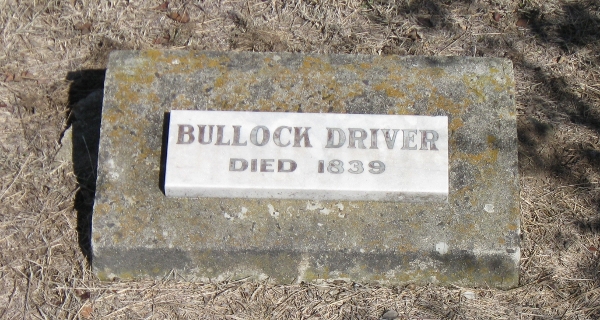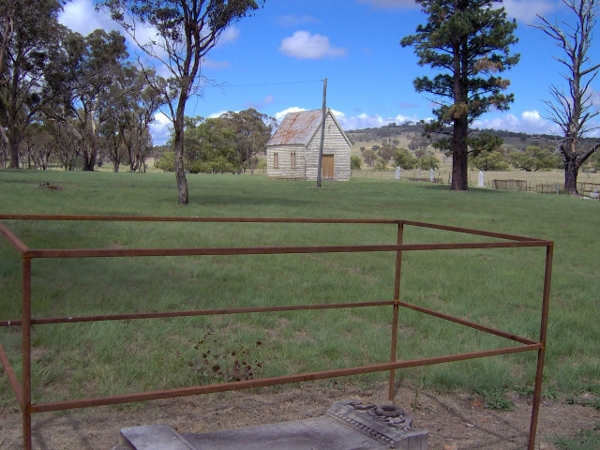These are two of the more challenging headstones for genealogists in the New England District. We are hoping that some of the knowledgeable online sleuths here may be able to give us a helping hand.
Bullock Driver – Rural Burial
“Bullock Driver – Died 1839” is buried in a family cemetery on Wellington Vale, a pastoral run, near Deepwater. I would love to put a name to this man who has been certainly well cared for in death by a family who did not even know his name. There is no death registration in Births, Deaths and Marriages that I can match with this headstone. As an interesting aside, Arthur Wellesly Robertson took up “Wellington Vale” in 1838 and named it after his godfather, the Duke of Wellington.
The image above is from the pastoral run Strathbogie. Rural burials are very common with the pastoral runs. Strathbogie Run shares a boundary with Wellington Vale to the East and Wellingrove to the south. All of these runs are to the west of the major transport corridor running from Glen Innes to Tenterfield.
Hannah Forden – Wellingrove Cemetery
Hannah Forden lies buried in the Wellingrove Cemetery to the west of Glen Innes. She has a large headstone with a clearly readable date of death,18th July 1880, but no registration in Births, Deaths and Marriages. Wellingrove is a pastoral run that grew to become a township. It had a Courthouse and a Police Station. However, by the time Hannah Forden passed away the community was already in decline with its population drifting away to nearby towns such as Vegetable Creek (Emmaville) and Glen Innes.
Usually we work from the evidence provided by the records of death. In these two cases, the memorial to the individual suggests the transfer of records was incomplete. The dynamic expansion of European settlement followed by the rapid transit of mining communities in and out of these areas provides these challenges.
Over to you…





Mick Reed says:
NSW Police Gazette
An entry for 2nd April 1879 has a warrant being issued at Glen Innes for a John Forden for deserting his wife Hannah leaving her with no means of support. He was arrested in July by Constable Malone of the Yetman Police. He was remanded at Glen Innes to be dealt with.
A John Forden married Anna Carter in Queensland 20 Sep 1869
Registration Number: 000180
Page Number: 2349
raymond says:
Google brought up this series of discussions about her, way back in 2004 and 2006:
http://genforum.genealogy.com/fordon/messages/3.html
Jeannette says:
I don’t know anything specifically about this, but I do trawl the BDM indexes a lot. So, here’s a bit of detective work. Forden is a late name in the NSW BDM. The earliest birth is 1886, Inverell; the earliest death is 1900, Wyalong; the earliest male marriage is 1886 Inverell (John Forden and Catherine Bourke), the earliest female marriage is 1887, Carcoar. So how is it that Hannah is buried in NSW in 1880?
Where did the Fordens come from? They could be immigrants but that doesn’t explain the 1880 headstone. One possibility is that they came from Queensland, given the marriage between John Forden and Anna Carter in 1869. (Anna/Hannah, even Susannah are common alternate spellings.) No births from that union, indeed only one Forden birth in Qld, George Forden 1877, f.Thomas, m.Susan. This George died 1860, apparently unmarried.
So, a guess/working hypothesis: John and Anna/Hannah moved from Qld to NSW between 1869-1880; she dies (after he deserts her!). John remarries Catherine Bourke in Inverell in 1885 (MC5557), and they have seven children between 1886-1899. Several of those marry in Inverell, but their descendants can’t be traced in the indexes (after 1911). To continue, it would be worth locating Forden descendants.
But if John deserted Hannah/Anne in 1879, who organised and paid for the elaborate headstone?
enno says:
well you probably already know this, but there was no official registration before 1857
enno says:
There is a Hannah Carter with death registered Inverell 1879
enno says:
That tombstone appear to say that Hannah Forden was born 1823.
The John Forden who married Catherine Bourke in 1885 at Inverell was supposedly 39 at that time indicating born around 1845.
If this is so, Hannah is rather old to be his first wife.
Janette Pelosi says:
Regarding the Bullocky who died in 1839:
I had a look at NRS 906, Itineraries of Commissioners of Crown Lands [X816 p.7] Reel 2748 for those of George James Macdonald, the Commissioner for New England, ( Agency 3498. On 3 and 4 September 1839 he visited Wellington Vale. There were 9 residents with 2 slab huts on the property which was 8 miles in extent and 4 miles from its nearest neighbour. The land was good for grazing, lightly wooded and was watered by a chain of ponds. The stock was 16 cattle, 4 horses and 2600 sheep! Kelso and Robinson held the license for the property and superintended it. The remarks column was of interest: “Shepherd killed by the Native’s here – Depositions taken & forwarded to Att[orne]y Gen[era]l.” [This is the language of the original record.] Was our bullocky a shepherd? Just to confuse things a similar death was noted on the previous page. Did our bullocky die in early 1839 (before the visit) or did he die in September 1839? Of course this is prior to NSW civil registration and there is no church record of his death. So is there any possibility of finding a name? Yes, NRS 343, Register of coroners inquests for 1 November 1839 [4/6611] Reel 2921 includes the two deaths reported by Macdonald. The two were George Metcalf who died 1 September (Inquest No.596) and also Richard Frew who died 6 September (Inquest No.597), both died at New England. Was one of these our bullocky?
Janette Pelosi says:
Further to my previous post on our bullocky:
I was able to locate the letter from Commissioner Macdonald ‘Forwarding “Itinerary” & “Census Return” (NRS 905, Letter No.39/11811 registered 1 November 1839 [4/2439.1]). Macdonald reports” ‘The only circumstances, the occurrence of which I have to lament since my arrival, have been the murder of 2 shepherds … one at the Station of the Messrs Kelso & Robertson and the other on that of a Mr Vivers: the Report in both these cases reached me two and three weeks after their occurrence, when I immediately proceeded to enquire into the circumstances in that spot, taking the necessary depositions, which have been duly forwarded to the Attorney General.’ Unfortunately for us these papers do not appear to have survived in the papers of the Attorney General so we may never know whether it was George Metcalf or Richard Frew who was the shepherd at Wellington Vale. Macdonald’s “Census” of 30 September 1839 in the same bundle records that Kelso & Robertson’s Wellington Vale station supported 7 males above 12 years of age, 1 female above 12 years and 1 male convict. Were Metcalf or Frew convicts also or maybe emancipists?
Tracy Fenn says:
I am a direct descendant of John Forden from his second marriage to Catherine Bourke. And yes Hannah was older than John when they married and going on immigration and QLD BDM records Hannah lied about her age when she married John Forden.
Hannah Forden was actually born on 20-8-1822 as her headstone states and she died 18-7-1880. Her 4 children buried her, not John Forden.
If you would like further information on Hannah there are family members who would be willing to help you.
Fiona Sullivan says:
Thanks for sharing the extra information @TracyFenn. I will pass it on to the team at the University of New England. It seems that you have the key to unlocking the mystery.